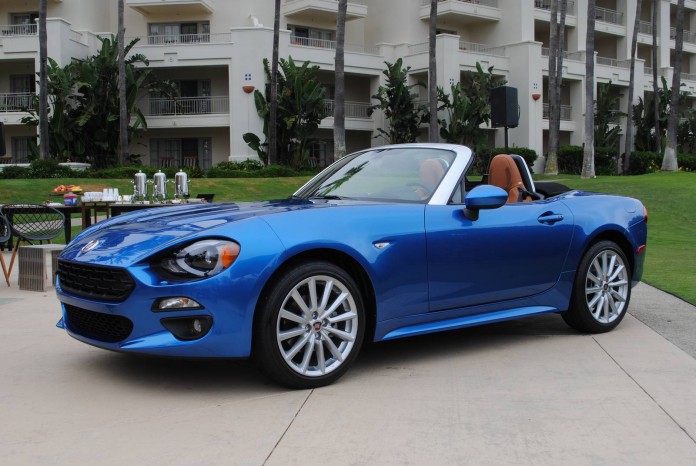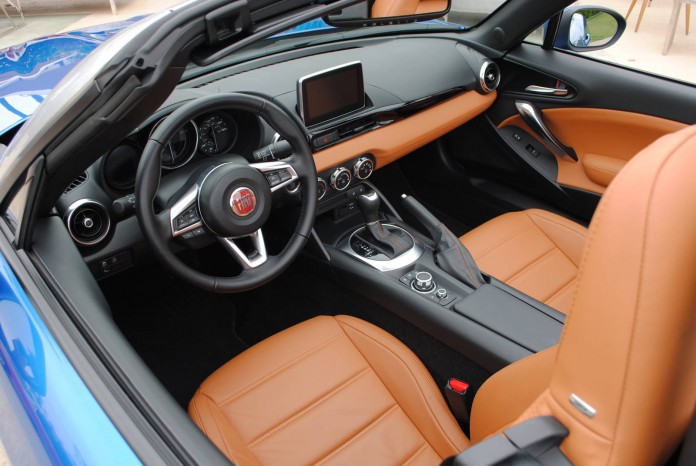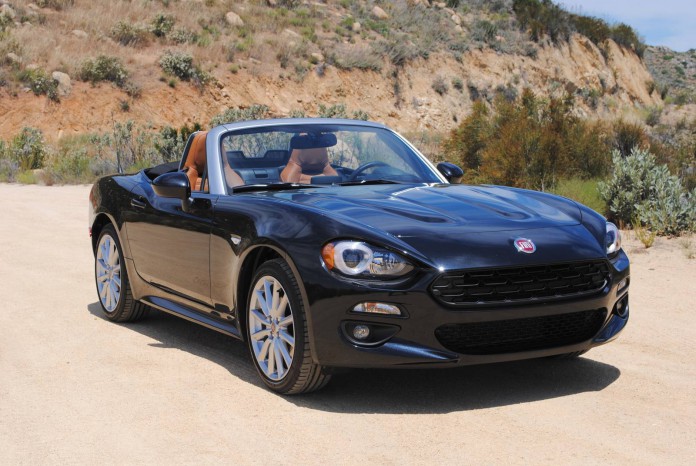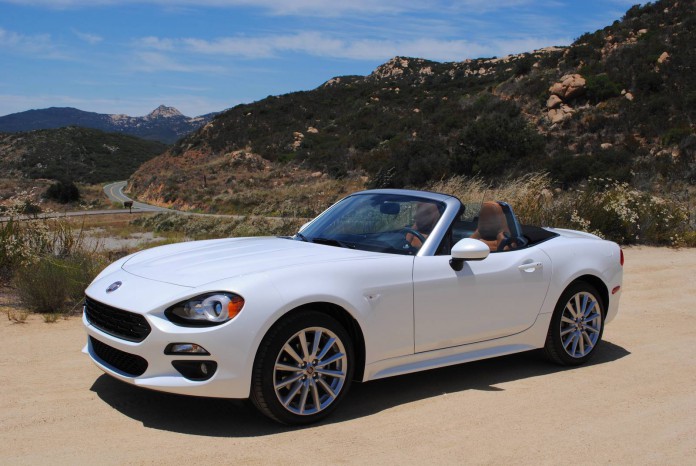About 20 minutes into our scheduled drive through the hills northeast of San Diego we arrived at roads so narrow and winding that an involuntary grin began spreading across our faces. These are the canyon roads California is so famous for. If you love driving, these are the kind of roads you spend your lunch hours at work searching for on Google Earth. Get a good grip on the wheel, drop a gear aaaaand left-right, left, left again, right. Drop a gear to climb out of the canyon then fall down the back side into another, sawing the steering wheel right, then left to follow the tight curves further up the canyon. Slow for a bicyclist with calf muscles the size of a bedroll, mentally recommit to your failed exercise regimen, then hammer further up the road, looking as far into the distance as you can, slipping into a state of zen where it’s just you and the car riding out this roller coaster of a road. This is something we’ve done many times in a Miata, only this is Fiat’s new 124 Spider. And it’s fantastic.
At the entry level end of the GT/sports car spectrum, the Fiat 124 Spider is an attractive new offering starting at about $26,000 USD. Not counting the beautiful blue but rare 124-unit limited-availability Prima Edizione, there are three available trim levels: Classico, Lusso, and Abarth. The Classico, or entry-level model, offers capable performance, simplicity, and fun driving. But if you’re the kind of person who wants more (and who doesn’t want more?), you can step up to the Lusso, which includes leather seats, extra sound insulation, and all the extra little things that make it more luxurious and comfortable to travel in; Or you can step up the Abarth, which focuses on extra performance, adding a limited-slip differential, more sporting Bilstein suspension, and more aggressive bodywork.
Fiat had scheduled a full day of driving for us and after receiving a brief presentation from the Project Manager, the Chief Interior Designer, and the Chief Engineer of the 124 Spider program, we were led up to the courtyard like excited children where we found several 124 Spiders waiting for us like colorful pieces of candy. For our back roads exploration, we were paired up and issued a Spider. The cars were a mix of Classicos and Lussos with a mixture of manual and automatic transmissions.
We grabbed a Lusso model to start, and followed the pre-planned route out into the bright sun and dry desert hills of Southern California. The top was down, the a/c was on, and we pushed the car through the winding back roads they’d routed us on. Despite it’s luxury mission, the Lusso followed the winding roads like a bloodhound following a scent. It was comfortable and athletic at the same time. We enjoyed the roller coaster roads for a few hours, then headed into San Diego for a break and more sunscreen.
After a relaxed lunch at the innovative Kettner Exchange restaurant downtown, we traded for a manual Classico and merged into the frenzied freeway traffic to Qualcomm Stadium to spend a few hours autocrossing a pair of bright red Abarth models – one an automatic with paddle shifters, the other a manual. We ripped around the circuit for a few hours, pushing the engine and suspension and learning their limits. Delighted with the car’s performance, we finally made our way over to Pacific Coast Highway and dawdled back to our hotel, enjoying the scenic ocean views and salty breezes while navigating through the thick Friday night traffic. Fiat had planned a day that would give us a sense of the car in about every conceivable situation and we came away impressed.
The new design pays homage to the original 124 Spider, introduced fifty years ago at the Turin Auto Show. It went on sale in 1968 and remained on the market until 1985. Fiat decided that for the fifty year anniversary, it would like to bring the 124 Spider back and joined into a cooperative effort with Mazda to create a joint platform that they could share. Mazda built the new ND MX-5 Miata and Fiat created their new 124 Spider. This new 124 has many of the styling features of the original, updated to the dimensions that todays safety and performance standards require.
When we first saw the car under the bright lights of the Detroit Auto Show it was hard to get a feel for the cohesive design of the car but in the flesh, under the sun, the details pop and the car has a sporting but graceful elegance to it like an athlete in an Italian suit. Fiat feels that the horizontal line along the side that curves up over the back wheel arch is the most important historical design cue, but we think the headlights and the grille shape are the highlights of the design and the most obvious link to the original car. The long hood with twin elongated blisters on it is another strong link. But Fiat didn’t stop at historical tie-ins. They really tried to give the car some special design cues.
The intricate LED headlights in particular are both unique and eye-catching. The backup lights integrated into the lower valence between the polished silver exhaust tips add a jeweled look. In the center of the red tail lamps is a body colored island that nicely ties in with the rest of the car. A lot of thought went into the design details on this new platform and the result is that it looks much more expensive than it really is.
The Abarth has a different lower front and rear valence than it’s sister models and is more aggressive looking. It adds a bit of menace to the design. Also available on the Abarth is a wide flat black stripe that follows onto the trunk. Back when Abarth raced in the sixties and seventies, everything was stripped off the car that wasn’t necessary in order to save weight. Many times, this included the paint itself. This tended to create terrible sun glare off the bare alloy so they painted the hoods and trunks flat black in order to keep drivers from being blinded. It’s a neat, if purely decorative, touch that further links the car to his predecessor.
A lot of the 124 Spider’s interior is shared with the MX-5 Miata, but it’s obvious that quite a lot of thought went into the interior design as well. Soft materials were used wherever possible, especially on the Lusso model, to create a more luxurious feeling for the occupants. The switchgear in the cockpit looks like precisely machined aluminum. Piano black trim pieces tastefully accent the Lusso’s interior.
The seats are very well bolstered and do a nice job of holding one in place in high-g corners. In fact, we didn’t need to brace ourselves like we do in the MX-5 while on the autocross circuit. They kept us comfortable all day long, only forcing us to remove our wallets after about 7 hours of driving.
The steering wheel is sportingly thick but not so thick that smaller hands will have an issue with it. Palm swells are strategically located at ten and two, felt great and aided control. The leather is soft but grippy and the power steering is well-weighted for sporting driving.
The shifter on the manual transmission falls readily to hand and the ball of the manual filled our hands nicely. Throws are short and effortless, without catching on any detentes or burrs. Gates are intuitive and effortless to find. The paddle shifters that are available with the automatic transmission on the Abarth model click cleanly and positively. They turn with the steering wheel.
The top is a soft, sound-insulated fabric that manually raises and lowers. It’s very light and is quite an easy operation from the drivers seat. When you release the top to raise it, it hops up high enough to get your hand under it, something we noticed didn’t always happen on the NC version of the Miata. Once in place, it latches with a single latch. With the top up and side windows sealed, you can carry on a normal conversation at freeway speeds without the need to raise your voice. To lower it, you simply turn the latch and throw the top back. It easily folds back and automatically locks into the basin behind the cockpit.
The 124 Spider is a front-engined, rear-wheel drive car. It’s powered by Fiat’s popular little 1.4L Turbo Multi-Air engine, which also powers the 500 Abarth to good effect. The engine is a pleasant enough mill to drive. It feels a tad coarse at idle but gets smooth as butter as the turbo supplies boost and it makes good torque throughout the rev range giving it a strong, broad powerband. You can feel the increased torque come on around 2200 rpm or so. It makes peak torque around 5500 but it stays strong right up to the 6250 rpm cutoff.
When channeling the turbo-four through the manual 6-speed transmission, you get a wonderful package to work with. Each redline shift drops you back down into the power band so you can continue your acceleration without distraction. They make a great combination. The automatic transmission, however, left us cold. It does alright on freeways or when cruising but it seemed confused by twisty roads. It power was needed it responded rather gracelessly, suddenly punting the tiny engine into the revs to deliver power, only to shift back to a higher gear again for economy before being punted back up to rev again when needed.
The result was that it felt noisy and harsh. In fact, we actually resorted to using the manumatic option on it when driving twisty roads because we couldn’t stand the normal automatic operation any longer. And we hate manumatics, so that should tell you something. We really don’t recommend the automatic unless you’re only buying the car for relaxed ice cream runs or leisurely tours. The automatic in the Abarth model, however, includes Sport Mode which allows the transmission to run more aggressively and without the need to constantly seek fuel economy. It allows the automatic to get a little more serious with the driver on back roads.
It also includes paddle shifters which introduce a degree of driver control that greatly improves things. They clicked off shifts with a decent degree of precision. They would probably work well on a fun road but on the autocross course, even in Sport Mode, the paddle shifts felt a bit slow. It would be nice to have them programmed to be a little more aggressive for autocross events – maybe a Race Mode to complement the Sport Mode on the Abarth?
The exhaust sound is sporty but not too loud for everyday driving. The Abarth has a different muffler than the Classico and the Lusso with a deeper, more serious note to it and an added 4 hp. We liked the sound of it and felt it was fitting for the Abarth.
The brakes are anti-lock four-wheel disc brakes and they do a great job of stopping the car. They were progressive, easy to modulate, and stopped the car quickly. On the Abarth model, there’s also an available Brembo brake option that provides red Brembo calipers. However, we were disappointed by the performance of the Brembo’s on the autocross circuit. They just didn’t feel like they were stopping the car quickly enough, compared to other cars like this we’ve driven. Given our great experience with the stock brakes and the fantastic reputation that Brembo enjoys, we suspect that maybe they were a little glazed from five days of autocross abuse at the hands of journalists.
Interestingly, there is only one world suspension tune for each model. Budgetary constraints dictated that all the world’s Classicos will have the same suspension tuning. So will all the Lusso’s and Abarths. So a German 124 Classico will have the same suspension tune as an Italian Classico. And American ones. And Japanese ones. And every country seems to have different preferences. With pressure like that, engineering HAD to get the suspension right and we’d say they found a good balance.
Tight twists in the canyon roads allowed the Spider to demonstrate its tight and flawless transitional responses. It soaked up crumbling roadway and camber changes effortlessly while still providing sports car performance. Not an easy feat but the little Fiat pulls it off. While we didn’t get a chance to really push either the Classico or Lusso too hard due to the public nature of the roads and their narrowness, we were still impressed with how well it followed the twisty roads at speed, even with loose gravel on them. We did get a chance to push the Abarth models on the autocross circuit though and we’re very pleased to report that with stability control turned off, you can push the tail out on sweeping curves with a little speed and easily control it.
There is great feedback as to what the suspension is doing and breakaway is very natural, controllable, and recoverable. It’s great fun. Very tossable. Fiat couldn’t offer the Abarth with a tighter suspension and all the accompanying downsides like harsh ride so they worked to provide the best balance of precision and comfort and we think they nailed it. Some die-hards will end up replacing the shocks and springs with something firmer, but the Abarth will be perfect for most sports car buyers.
In cars – especially open cars – there are good sounds and bad sounds, good motions and bad ones. Fiat’s engineers worked hard to keep the good sounds and motions while eliminating the bad ones and it paid off in spades. There are eight vibration dampeners in the cockpit, extra sound deadening material in the soft top, and acoustical glass (a layer of sound deadening film between two sheets of safety glass) for the windshield and rear window. Even the seatbelt shoulder reel anchors were moved inside the slipstream to reduce wind noise.
Fiat worked hard to improve the NVH of the platform and while the car ends up weighing about 100 lbs more than its sister-platform, its a better quality car for it. It feels more refined than the Miata. Not softer but instead more finished, more expensive, and without any real noticeable loss of ability. One of the cars they had on hand for comparison was a new Club edition MX-5 and we took the time to drive it, paying special attention to the feel and sound of it. I’m surprised to find myself saying that I preferred the 124. They’re both good cars, but the 124 just feels more…special.
Fiat has a number of Mopar upgrades ready for release as well. Everything from braces and a louder Record Monza Exhaust System to graphic decals, car covers, and grille badges to personalize your own with. Of particular note is a Mopar blow-off valve for the tiny turbo engine. It doesn’t add any performance but the PSSSSSHHHH! sound it makes when venting extra boost pressure is worth the price of admission. And the car will most likely soon benefit from a raft of other aftermarket accessories as well, if the presence at the autocross circuit of a very interested and smiling Brian Goodwin – of Good Win Racing, one of the leading Miata aftermarket parts specialists – was any indication.
At GTSpirit, we like to rate cars and their characteristics after we drive them. However, we drive cars at every level of the spectrum so it’s hard to compare the entry-level Fiat 124 Spider to, say, something like a Mercedes-AMG GT or a McLaren 675 LT. The abilities and performance are world’s apart. We’ll just say this: In the $25-30,000 USD range, this car’s only competition is its Japanese twin. The MX-5 is certainly right there with it, but nothing else comes close.
Most times, when two car companies as diverse as a Japanese one and an Ital-American one engage in a joint venture like this, things go horribly wrong. In this case, Fiat has sweated the details and it’s paid off. The Fiat 124 Spider is a capable and fun little sports car on par with its platform mate, which is a great start, but it goes one further and improves a lot of the little things that Mazda decided to leave alone, either in the interest of weight savings or budgetary constraints, and it makes for a slightly more pleasing, more satisfying experience. Fiat has taken a great platform and made it even better, which is destined to make the 124 Spider a new classic.





























































